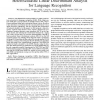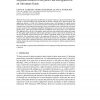9 search results - page 1 / 2 » A dynamic approach to the selection of high order n-grams in... |
ICASSP
2011
IEEE
12 years 9 months ago
2011
IEEE
Due to computational bounds, most SVM-based phonotactic language recognition systems consider only low-order n-grams (up to n = 3), thus limiting the potential performance of this...
INTERSPEECH
2010
13 years 5 days ago
2010
One successful approach to language recognition is to focus on the most discriminative high level features of languages, such as phones and words. In this paper, we applied a simi...
TASLP
2011
13 years 9 days ago
2011
Abstract—The shifted delta cepstrum (SDC) is a widely used feature extraction for language recognition (LRE). With a high context width due to incorporation of multiple frames, S...
ICIP
2006
IEEE
14 years 7 months ago
2006
IEEE
Video based analysis of a persons' mood or behavior is in general performed by interpreting various features observed on the body. Facial actions, such as speaking, yawning o...
UMUAI
1998
13 years 5 months ago
1998
We present an approach to keyhole plan recognition which uses a dynamic belief (Bayesian) network to represent features of the domain that are needed to identify users’ plans and...


